Английский язык, Тексты для чтения и написания эссе по проблемным темам мировых железнодорожных технологий в новых условиях, Кузякин А.С., Ерастова Д.А., 2021.
«Английский язык: Тексты для чтения и написания эссе по проблемным темам железнодорожных технологий в новых условиях» представляет собой учебно-методическое пособие, содержащее оригинальные публицистические статьи по различным аспектам железнодорожного транспорта. Пособие является продолжением аналогичного издания 2020 года. Полностью обновлен состав статей, многие из которых освещают работу железнодорожной отрасли в период пандемии Сovid-19. Шесть глав пособия соответствуют шести рубрикам сайта Railway Technology, а именно: высокоскоростные железные дороги, пассажирская служба, инфраструктура, эксплуатация железнодорожного транспорта, городской железнодорожный транспорт, цифровые технологии на железных дорогах. В данное пособие включены только публицистические статьи, в которых важные отраслевые проблемы описываются как совокупность фактов и мнений. Написание эссе на базе высказанных в статьях мнений и личного опыта студентов планируется как самостоятельная домашняя работа, вписывающаяся в дистанционный формат обучения.
Учебно-методическое пособие «Английский язык: Тексты для чтения и написания эссе по проблемным темам мировых железнодорожных технологий в новых условиях» предназначен для студентов неязыковых вузов, изучающих английский язык в сфере эксплуатации железнодорожного транспорта.
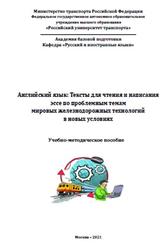
The role of external factors.
Although not decisive in Frecciarossa’s derailment, external factors like adverse weather and natural disasters are an increasingly tougher challenge for HSR operators as climate change tightens its grip over the world.
A case in point, earlier in March a TGV train derailed in southern France as a result of a landslide, leaving over 20 injured. The latest of an ever-increasing list, France’s accident is symptomatic of networks’ constant exposure to unpredictable natural events and a higher degree of risk.
Some networks are already investing heavily in the development of resilience and prevention measures. A prime example is the upcoming Rail Baltica line, which will connect Latvia, Estonia and Lithuania. The engineers recently published a study assessing the impacts of expected climate variations on the upcoming line.
Meanwhile, Bugalia points out that many existing networks have already adapted to cope with risks. Japan has long been a pioneer in this field, finding itself located in a rather unwelcoming land where earthquakes are frequent and difficult to tackle.
Here, measures to prevent accidents include emergency braking systems and trackside signals that can detect obstruction. “Although such external factors pose a high risk, the HSR systems have been strengthened to mitigate the risks to certain extents,” says Bugalia. “Nevertheless, with increasing rainfalls, typhoons, and erratic weather patterns the HSR systems will have to be further developed.”
CONTENTS.
1 HIGH-SPEED.
1.1 Russian revolution: is the Moscow-Kazan high-speed rail project on track?.
1.2 Is high-speed rail the fast track to transport decarbonisation?.
1.3 Is Brightline on track to revolutionise high-speed rail in the US?.
1.4 Safety on high-speed rail: preventing disaster at hundreds of miles per hour.
1.5 Magnetic pull: China and Japan battle it out for maglev train supremacy.
2 PASSENGER.
2.1 Is the ‘death of the commute’ forcing a ticketing rethink?.
2.2 Rail pastors: the volunteers saving lives on the UK rail network.
2.3 Stopping it in its tracks: the fight to deter trespassers on Britain’s railways.
2.4 Putting Passengers First: how UK railway contractors are becoming more user centric.
2.5 The nudge: how to influence railway passenger behaviour.
3 INFRASTRUCTURE.
3.1 Rail innovation: is Australia falling behind?.
3.2 Welcoming the European Year of Rail.
3.3 Rail-air freight: can it work?.
3.4 Rail fine dining: the best and worst in on-board catering.
3.5 Stonehaven rail crash: key lessons to learn.
4 OPERATION.
4.1 Saving France’s rural railways: is there a light at the end of the tunnel?.
4.2 High-tech products and digital service concepts: The key to success for modern railway networks.
4.3 Will coal trains boost local cancer risk?.
4.4 Is Germany’s love affair with DB unfair to other operators?.
4.5 Different track: inside the UK’s new Rail Technical Strategy.
5 URBAN.
5.1 The people’s palace: exploring Moscow Metro’s evolving designs.
5.2 From London’s Deep Tube to Moskva Metro: the world’s most modern trains.
5.3 A culture trip on themed trains.
5.4 Track and trace: keeping the railways free from Covid-19.
5.5 Keeping heritage railways alive during Covid-19.
6 TECHNOLOGY.
6.1 Energy Floors – Russian railways harness passenger power.
6.2 Ready for all weather.
6.3 Siemens Mobility brings Stratasys 3D printing to Russian rail industry.
6.4 Rail freight: Breakthrough into the digital logistics ecosystem.
6.5 Aerial analytics: Laying the tracks of a new intelligence.
Бесплатно скачать электронную книгу в удобном формате, смотреть и читать:
Скачать книгу Английский язык, Тексты для чтения и написания эссе по проблемным темам мировых железнодорожных технологий в новых условиях, Кузякин А.С., Ерастова Д.А., 2021 - fileskachat.com, быстрое и бесплатное скачивание.
Скачать pdf
Ниже можно купить эту книгу, если она есть в продаже, и похожие книги по лучшей цене со скидкой с доставкой по всей России.Купить книги
Скачать - pdf - Яндекс.Диск.
Дата публикации:
Теги: учебник по английскому языку :: английский язык :: Кузякин :: Ерастова
Смотрите также учебники, книги и учебные материалы:
Следующие учебники и книги:
 Английский язык, Linking words, Слова-связки в английском языке, Пособие по обучению лексике, Ляхнович Т.Л., 2020 — Цель данного пособия - помочь учащимся овладеть словами и короткими фразами, правильное употребление которых позволит грамотно выражать свои мысли, четко … Книги по английскому языку
Английский язык, Linking words, Слова-связки в английском языке, Пособие по обучению лексике, Ляхнович Т.Л., 2020 — Цель данного пособия - помочь учащимся овладеть словами и короткими фразами, правильное употребление которых позволит грамотно выражать свои мысли, четко … Книги по английскому языку Английский для юристов, Лебедева А.А., 2017 — Учебник построен в соответствии с требованиями Государственного образовательного стандарта высшего профессионального образования по специальности Юриспруденция с учетом специфики обучения студентов … Книги по английскому языку
Английский для юристов, Лебедева А.А., 2017 — Учебник построен в соответствии с требованиями Государственного образовательного стандарта высшего профессионального образования по специальности Юриспруденция с учетом специфики обучения студентов … Книги по английскому языку Перевод русских фразеологизмов на английский язык, Кузьмин С.С., 1977 — Цель пособия помочь студенту овладеть способами и средствами перевода русских фразеологизмов на английский язык, научить его анализировать процесс перевода в … Книги по английскому языку
Перевод русских фразеологизмов на английский язык, Кузьмин С.С., 1977 — Цель пособия помочь студенту овладеть способами и средствами перевода русских фразеологизмов на английский язык, научить его анализировать процесс перевода в … Книги по английскому языку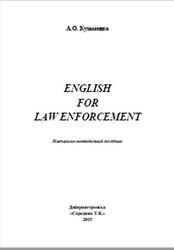 English for law enforcement, Навчально-методичний посібник, Кузьменко А.О., 2015 — Навчально-методичний посібник є спробою полегшити вивчення іноземної мови (англійської) для правоохоронних органів, вдосконалити іншомовну компетенцію слухача. Ця мета досягається шляхом … Книги по английскому языку
English for law enforcement, Навчально-методичний посібник, Кузьменко А.О., 2015 — Навчально-методичний посібник є спробою полегшити вивчення іноземної мови (англійської) для правоохоронних органів, вдосконалити іншомовну компетенцію слухача. Ця мета досягається шляхом … Книги по английскому языку
Предыдущие статьи:
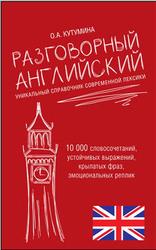 Разговорный английский, Уникальный справочник современной лексики, Кутумина О.А., 2014 — Книга представляет собой практическое справочное пособие. Пособие включает фразеологические единицы, часто встречающиеся в разговорной речи: устойчивые словосочетания, эмоциональные реплики и … Книги по английскому языку
Разговорный английский, Уникальный справочник современной лексики, Кутумина О.А., 2014 — Книга представляет собой практическое справочное пособие. Пособие включает фразеологические единицы, часто встречающиеся в разговорной речи: устойчивые словосочетания, эмоциональные реплики и … Книги по английскому языку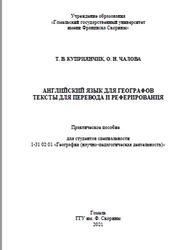 Английский язык для географов, Тексты для перевода и реферирования, Практическое пособие, Куприянчик Т.В., Чалова О.Н., 2021 — Практическое пособие содержит восемь текстов географического профиля для чтения на английском языке, а также комплекс упражнений, направленных на развитие у … Книги по английскому языку
Английский язык для географов, Тексты для перевода и реферирования, Практическое пособие, Куприянчик Т.В., Чалова О.Н., 2021 — Практическое пособие содержит восемь текстов географического профиля для чтения на английском языке, а также комплекс упражнений, направленных на развитие у … Книги по английскому языку Anglish grammar practice book, Krylova I.P. — Фрагмент из книги: 1. He had to satisfy the editor s requirements that a short story (not to exceed) one … Книги по английскому языку
Anglish grammar practice book, Krylova I.P. — Фрагмент из книги: 1. He had to satisfy the editor s requirements that a short story (not to exceed) one … Книги по английскому языку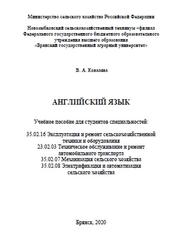 Английский язык, учебное пособие, Ковалёва В.А., 2015 — Данное учебное пособие предназначено для студентов средних специальных учебных заведений по специальностям 35.02.16 Эксплуатация и ремонт сельскохозяйственной техники и оборудования, … Книги по английскому языку
Английский язык, учебное пособие, Ковалёва В.А., 2015 — Данное учебное пособие предназначено для студентов средних специальных учебных заведений по специальностям 35.02.16 Эксплуатация и ремонт сельскохозяйственной техники и оборудования, … Книги по английскому языку




